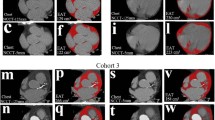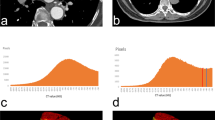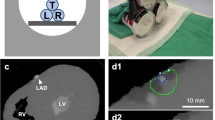Abstract
Recent studies have suggested that pericardial adipose tissue (PAT) located in close vicinity to the epicardial coronary arteries may play a role in the development of coronary artery disease. PAT has primarily been measured with cardiac magnetic resonance imaging (CMRI) or with non-contrast cardiac multidetector computered tomography (MDCT) images. The aim of this study was to validate contrast MDCT derived measures of total PAT volume by a comparison to CMRI. In 52 patients, aged 60 years (34–81 years), Body Mass Index 28 kg/m2 (18–39), and with stable ischemic heart disease, paired MDCT and CMRI scans were performed. The optimal fit for measuring PAT using contrast MDCT was developed and validated by the corresponding measures on CMRI. The median for PAT volume in patients was 175 ml (SD 68) and 153 ml (SD 60) measured by MDCT and CMRI respectively. Four different attenuation values were tested, and the smallest difference in PAT was noted when −30 to −190 HU were used in MDCT measures. The median difference between MDCT and CMRI for the assessment of PAT was 9 ml (SD 50) suggesting a reasonable robust method for the assessment of PAT in a large-scale study. Pericardial adipose tissue can be measured on standard coronary CT angiography images with a reasonable degree of accuracy when compared to CMRI.




Similar content being viewed by others
References
Rosito GA, Massaro JM, Hoffmann U, Ruberg FL, Mahabadi AA, Vasan RS et al (2008) Pericardial fat, visceral abdominal fat, cardiovascular disease risk factors, and vascular calcification in a community-based sample: the Framingham Heart Study. Circulation 117:605–613
Taguchi R, Takasu J, Itani Y, Yamamoto R, Yokoyama K, Watanabe S et al (2001) Pericardial fat accumulation in men as a risk factor for coronary artery disease. Atherosclerosis 157:203–209
Nakanishi R, Rajani R, Cheng VY, Gransar H, Nakazato R, Shmilovich H et al (2011) Increase in epicardial fat volume is associated with greater coronary artery calcification progression in subjects at intermediate risk by coronary calcium score: a serial study using non-contrast cardiac CT. Atherosclerosis 218:363–368
Harada K, Amano T, Uetani T, Tokuda Y, Kitagawa K, Shimbo Y et al (2011) Cardiac 64-multislice computed tomography reveals increased epicardial fat volume in patients with acute coronary syndrome. Am J Cardiol 108:1119–1123
Rabkin SW (2007) Epicardial fat: properties, function and relationship to obesity. Obes Rev 8:253–261
Mazurek T, Zhang L, Zalewski A, Mannion JD, Diehl JT, Arafat H et al (2003) Human epicardial adipose tissue is a source of inflammatory mediators. Circulation 108:2460–2466
Greif M, Becker A, von Ziegler F, Lebherz C, Lehrke M, Broedl UC et al (2009) Pericardial adipose tissue determined by dual source ct is a risk factor for coronary atherosclerosis. Arterioscler Thromb Vasc Biol 29:781–786
Gorter PM, Van Lindert ASR, De Vos AM, Meijs MFL, Van der Graaf Y, Doevendans PA et al (2008) Quantification of epicardial and peri-coronary fat using cardiac computed tomography; reproducibility and relation with obesity and metabolic syndrome in patients suspected of coronary artery disease. Atherosclerosis 197:896–903
Dey D, Suzuki Y, Suzuki S, Ohba M, Slomka PJ, Polk D et al (2008) Automated quantitation of pericardiac fat from noncontrast CT. Invest Radiol 43:145–153
Tamarappoo B, Dey D, Shmilovich H, Nakazato R, Gransar H, Cheng VY et al (2010) Increased pericardial fat volume measured from noncontrast CT predicts myocardial ischemia by SPECT. JACC Cardiovasc Imaging 3:1104–1112
Abate N, Burns D, Peshock RM, Garg A, Grundy SM (1994) Estimation of adipose tissue mass by magnetic resonance imaging: validation against dissection in human cadavers. J Lipid Res 35:1490–1496
Lønborg JT, Engstrøm T, Møller JE, Ahtarovski KA, Kelbæk H, Holmvang L et al (2012) Left atrial volume and function in patients following ST elevation myocardial infarction and the association with clinical outcome: a cardiovascular magnetic resonance study. Eur Heart J Cardiovasc Imaging. doi:10.1093/ehjci/jes118
Sacks HS, Fain JN (2007) Human epicardial adipose tissue: a review. Am Heart J 153:907–917
Iacobellis G, Corradi D, Sharma AM (2005) Epicardial adipose tissue: anatomic, biomolecular and clinical relationships with the heart. Nat Clin Pract Cardiovasc Med 2:536–543
Wheeler GL, Shi R, Beck SR, Langefeld CD, Lenchik L, Wagenknecht LE et al (2005) Pericardial and visceral adipose tissues measured volumetrically with computed tomography are highly associated in type 2 diabetic families. Invest Radiol 40:97–101
Rössner S, Bo WJ, Hiltbrandt E, Hinson W, Karstaedt N, Santago P et al (1990) Adipose tissue determinations in cadavers–a comparison between cross-sectional planimetry and computed tomography. Int J Obes 14:893–902
Schlett CL, Ferencik M, Kriegel MF, Bamberg F, Ghoshhajra BB, Joshi SB et al (2012) Association of pericardial fat and coronary high-risk lesions as determined by cardiac CT. Atherosclerosis 222:129–134
Gorter PM, De Vos AM, Van der Graaf Y, Stella PR, Doevendans PA, Meijs MFL et al (2008) Relation of epicardial and pericoronary fat to coronary atherosclerosis and coronary artery calcium in patients undergoing coronary angiography. Am J Cardiol 102:380–385
Sjöström L, Kvist H, Cederblad A, Tylén U (1986) Determination of total adipose tissue and body fat in women by computed tomography, 40 K, and tritium. Am J Physiol 250:E736–E745
Yong HS, Kim EJ, Seo HS, Kang E-Y, Kim YK, Woo OH et al (2010) Pericardial fat is more abundant in patients with coronary atherosclerosis and even in the non-obese patients: evaluation with cardiac CT angiography. Int J Cardiovasc Imaging 26(Suppl 1):53–62
Yerramasu A, Dey D, Venuraju S, Anand DV, Atwal S, Corder R et al (2012) Increased volume of epicardial fat is an independent risk factor for accelerated progression of sub-clinical coronary atherosclerosis. Atherosclerosis 220:223–230
Shmilovich H, Dey D, Cheng VY, Rajani R, Nakazato R, Otaki Y et al (2011) Threshold for the upper normal limit of indexed epicardial fat volume: derivation in a healthy population and validation in an outcome-based study. Am J Cardiol 108:1680–1685
Nakazato R, Rajani R, Cheng VY, Shmilovich H, Nakanishi R, Otaki Y et al (2012) Weight change modulates epicardial fat burden: a 4-year serial study with non-contrast computed tomography. Atherosclerosis 220:139–144
Dey D, Nakazato R, Li D, Berman DS (2012) Epicardial and thoracic fat—Noninvasive measurement and clinical implications. Cardiovasc Diagn Ther 2:85–93
Positano V, Gastaldelli A, Sironi AM, Santarelli MF, Lombardi M, Landini L (2004) An accurate and robust method for unsupervised assessment of abdominal fat by MRI. J Magn Reson Imaging 20:684–689
Nelson AJ, Worthley MI, Psaltis PJ, Carbone A, Dundon BK, Duncan RF et al (2009) Validation of cardiovascular magnetic resonance assessment of pericardial adipose tissue volume. J Cardiovasc Magn Reson 11:15
Gaborit B, Kober F, Jacquier A, Moro PJ, Flavian A, Quilici J et al (2012) Epicardial fat volume is associated with coronary microvascular response in healthy subjects: a pilot study. Obesity (Silver Spring) 20:1200–1205
Gaborit B, Kober F, Jacquier A, Moro PJ, Cuisset T, Boullu S et al (2012) Assessment of epicardial fat volume and myocardial triglyceride content in severely obese subjects: relationship to metabolic profile, cardiac function and visceral fat. Int J Obes (Lond) 36:422–430
Conflict of interest
None.
Author information
Authors and Affiliations
Corresponding author
Rights and permissions
About this article
Cite this article
Elming, M.B., Lønborg, J., Rasmussen, T. et al. Measurements of pericardial adipose tissue using contrast enhanced cardiac multidetector computed tomography—comparison with cardiac magnetic resonance imaging. Int J Cardiovasc Imaging 29, 1401–1407 (2013). https://doi.org/10.1007/s10554-013-0218-6
Received:
Accepted:
Published:
Issue Date:
DOI: https://doi.org/10.1007/s10554-013-0218-6




